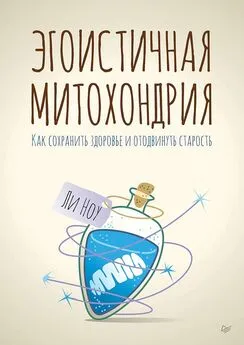Ли Ноу - Эгоистичная митохондрия. Как сохранить здоровье и отодвинуть старость
- Название:Эгоистичная митохондрия. Как сохранить здоровье и отодвинуть старость
- Автор:
- Жанр:
- Издательство:Питер
- Год:2020
- Город:Санкт-Петербург
- ISBN:978-5-4461-1021-6
- Рейтинг:
- Избранное:Добавить в избранное
-
Отзывы:
-
Ваша оценка:
Ли Ноу - Эгоистичная митохондрия. Как сохранить здоровье и отодвинуть старость краткое содержание
В нашем организме работают крошечные «энергетические станции» — митохондрии. Именно они отвечают за наше здоровье и отличное самочувствие. Когда они работают хорошо, мы не испытываем недостатка в энергии. А когда плохо — страдаем от заболеваний. Доктор Ли Ноу открывает тайну: заболевания, которые кажутся не связанными между собой на первый взгляд: диабет, рак, шизофрения, хроническая усталость, болезнь Паркинсона и другие — имеют общую природу.
Сегодня нам известно, как улучшить работу митохондрий, обеспечивающих организм энергией на 90 %. В этой книге вас ждет актуальная информация о питании, образе жизни, кетогенной диете и добавках, которые возвращают здоровье митохондриям, а следовательно, и нам.
Эгоистичная митохондрия. Как сохранить здоровье и отодвинуть старость - читать онлайн бесплатно ознакомительный отрывок
Интервал:
Закладка:
Nakamura K. α-Synuclein and mitochondria: partners in crime? Neurotherapeutics. 2013 Jul; 10(3):391–9. Epub Mar 20. doi:10.1007/s13311-013-0182-9.
Olanow C. W., et al. The effect of deprenyl and levodopa on the progression of Parkinson’s disease. Ann Neurol. Nov 1995; 38(5):771–7. doi:10.1002/ ana.410380512.
Perfeito R., Cunha-Oliveira T., Rego A. C. Revisiting oxidative stress and mitochondrial dysfunction in the pathogenesis of Parkinson’s disease — resemblance to the effect of amphetamine drugs of abuse. Free Radic Biol Med. 2012 Nov 1; 53(9):1791–806. doi:10.1016/j.freerad-biomed.2012.08.569.
Przedborski S., Jackson-Lewis V., Fahn S. Antiparkinsonian therapies and brain mitochondrial complex I activity. Mov Disord. May 1995; 10(3):312–7. doi:10.1002/mds.870100314.
Schapira A. H., et al. Novel pharmacological targets for the treatment of Parkinson’s disease. Nat Rev Drug Discov. 2006 Oct; 5(10):845–54. doi:10.1038/nrd2087.
Shults C. W., et al. Carbidopa/levodopa and selegiline do not affect platelet mitochondrial function in early Parkinsonism. Neurol. 1995 Feb; 45(2):344–8. doi:10.1212/WNL.45.2.344.
Shults C. W., et al. Coenzyme Q10 levels correlate with the activities of complexes I and II/III in mitochondria from parkinsonian and nonpar-kinsonian subjects. Ann Neurol. 1997 Aug. 42(2):261–4. doi:10.1002/ ana.410420221.
Shults C. W., et al. Absorption, tolerability, and effects on mitochondrial activity of oral coenzyme Q10 in parkinsonian patients. Neurology. 1998 Mar; 50(3):793–5. doi:10.1212 /WNL.50.3.793.
Shults C. W., Haas R. H., Beal M. F. A possible role of coenzyme Q10 in the etiology and treatment of Parkinson’s disease. Biofactors. 1999; 9(2–4):267–72. doi:10.1002/biof.5520090223.
Smith T. S., Parker W. D., Bennell J. P. Jr. L-dopa increases nigral production of hydroxyl radicals in vivo: potential L-dopa toxicity? Neuroreportl. 1994 Apr 14; 5(8):1009–11. doi:10.1097/00001756-199404000-00039.
Subramaniam S. R., Chesselet M. F. Mitochondrial dysfunction and oxidative stress in Parkinson’s disease. Prog Neurobiol. 2013 Jul — Aug;
106–107:17–32. Epub 2013 Apr 30. doi:10.1016/j.pneurobio.2013.04.004. Thomas B., Beal M. F. Mitochondrial therapies for Parkinson’s disease. Mov Disord. 2010; 25 Suppl 1:S155–S160. doi:10.1002/mds.22781.
Trempe J. F., Fon E. A. Structure and function of Parkin, PINK1, and DJ-1, the Three Musketeers of neuroprotection. Front Neurol. 2013 Apr 19; 4:38. doi:10.3389/fneur.2013.00038.
Wu R. M., et al. Apparent antioxidant effect of L-deprenyl on hydroxyl radical generation and nigral injury elicited by MPP+ in vivo. Eur J Pharmacol. 1993 Oct 26; 243(3):241–7. doi:10.1016/0014-2999(93)90181-G.
Hroudova J., et al. Mitochondrial respiration in blood platelets of depressive patients. Mitochondrion. 2013 Nov; 13(6):795–800. Epub May 17. doi:10.1016/j.mito.2013.05.005.
Lopresti A. L., Hood S. D., Drummond P. D. A review of lifestyle factors that contribute to important pathways associated with major depression: diet, sleep and exercise. J Affect Disord. 2013 May 15; 148(1):12–27. Epub Feb 14. doi:10.1016/j.jad.2013.01.014.
Morava E., Kozicz T. The economy of stress (mal)adaptation. Neurosci Biobehav Rev. 2013 May; 37(4):668–80. Epub 2013 Feb 13. doi:10.1016/j. neubiorev.2013.02.005.
Seibenhener M. L., et al. Behavioral effects of SQSTM1/p62 overexpression in mice: support for a mitochondrial role in depression and anxiety. Behav Brain Res. 2013 Jul 1;248:94–103. Epub Apr 13. doi:10.1016/j. bbr.2013.04.006.
Tobe E. H. Mitochondrial dysfunction, oxidative stress, and major depressive disorder. Neuropsychiatr Dis Treat. 2013; 9:567–73. Epub 2013 Apr 26. doi:10.2147/NDT.S44282.
Attwell D., Gibb A. Neuroenergetics and the kinetic design of excitatory synapses. Nat Rev Neurosci. 2005 Nov;6(11):841–9. doi:10.1038/nrn1784. Barkley R. A. Behavioral inhibition, sustained attention, and executive functions: constructing a unifying theory of ADHD. Psychol Bull. 1997 Jan; 121(1):65–94. doi:10.1037/0033-2909.121.1.65.
Castellanos F. X., Tannock R. Neuroscience of attention-deficit/hyperactivity disorder: the search for endophenotypes. Nat Rev Neurosci. 2002 Aug; 3(8):617–628. doi:10.1038/nrn896.
Charlton R. A., et al. White matter damage on diffusion tensor imaging correlates with age-related cognitive decline. Neurology. 2006 Jan 24; 66(2):217–22. doi:10.1212/01. wnl.0000194256.15247.83.
Chovanova Z., et al. Effect of polyphenolic extract, pycnogenol, on the level of 8-oxoguanine in children suffering from attention deficit/hyperactivity disorder. Free Radic Res. 2006 Sep; 40(9):1003–10. doi:10.1080/10715760600824902.
Cotter D. R., Pariante C. M., Everall I. P. Glial cell abnormalities in major psychiatric disorders: the evidence and implications. Brain Res Bull. 2001 Jul 15; 55(5):585–95. doi:10.1016 /S0361-9230(01)00527-5.
Dienel G. A. Astrocytic energetics during excitatory neurotransmission: what are contributions of glutamate oxidation and glycolysis? Neurochem Int. 2013 Oct; 63(4):244–58. Epub 2013 Jul 6. doi:10.1016/j. neuint.2013.06.015.
Dvorakova M., et al. The effect of polyphenolic extract from pine bark, pycnogenol on the level of glutathione in children suffering from attention deficit hyperactivity disorder (ADHD). Redox Rep. 2006; 11(4):163–72. doi:10.1179/135100006X116664.
Dvorakova M., et al. Urinary catecholamines in children with attention deficit hyperactivity disorder (ADHD): modulation by a polyphenolic extract from pine bark (pycnogenol). Nutr Neurosci. 2007 Jun — Aug;10(3–4):151–7. doi:10.1080/09513590701565443.
Ernst M., et al. Intravenous dextroamphetamine and brain glucose metabolism. Neuropsychopharmacology. 1997 Dec, 17(6):391–401. doi:10.1016/ S0893-133X(97)00088-2.
Fagundes A. O., et al. Chronic administration of methylphenidate activates mitochondrial respiratory chain in brain of young rats. Int J Dev Neurosci. 2007 Feb; 25(1):47–51. Epub 2006 Dec 22. doi:10.1016/j. ijdevneu.2006.11.001.
Gladden L. B. Lactate metabolism: a new paradigm for the third millennium. J Physiol. 2004 Jul 1;558(1):5–30.
Hansson E., Ronnback L. Altered neuronal-glial signaling in glutamatergic transmission as a unifying mechanism in chronic pain and mental fatigue. Neurochem Res. 2004 May; 29(5):989–96.
Hirst W. D., et al. Cultured astrocytes express messenger RNA for multiple serotonin receptor subtypes, without functional coupling of 5-HT1 receptor subtypes to adenylyl cyclase. Brain Res Mol Brain Res. 1998 Oct 30; 61(1–2):90–9. doi:10.1016/S0169-328X(98)00206-X.
Jessen K. R. Glial cells. Int J Biochem Cell Biol. 2004 Oct;36(10):1861–7. doi:10.1016/j.biocel.2004.02.023.
Karayanidis F., et al. ERP differences in visual attention processing between attention-deficit hyperactivity disorder and control boys in the absence of performance differences. Psychophysiology. 2000 May; 37(3):319–33. doi:10.1111/1469-8986.3730319.
Kasischke K. A., et al. Neural activity triggers neuronal oxidative metabolism followed by astrocytic glycolysis. Science. 2004 Jul 2; 305(5608):99– 103. doi:10.1126/science.1096485.
Klorman R., et al. Methylphenidate speeds evaluation processes of attention deficit disorder adolescents during a continuous performance test. J Abnorm Child Psychol. 1991 Jun; 19(3):263–83.
Lepine R., Parrouillet P., Camos V. What makes working memory spans so predictive of high-level cognition? Psychon Bull Rev. 2005 Feb; 12(1):165–70. Magistretti P. J., Pellerin L. Cellular mechanisms of brain energy metabolism and their relevance to functional brain imaging. Philos Trans R Soc Lond B Biol Sci. 1999 Jul 29; 354(1387):1155–63. doi:10.1098/ rstb.1999.0471.
Miyazaki I., et al. Direct evidence for expression of dopamine receptors in astrocytes from basal ganglia. Brain Res. 2004 Dec 10; 1029(1):120–3. doi:10.1016/j.brainres.2004.09.014.
Moldrich R. X., et al. Astrocyte mGlu(2/3)-mediated cAMP potentiation is calcium sensitive: studies in murine neuronal and astrocyte cultures. Neuropharmacology. 2002 Aug;43(2):189–203. doi:10.1016/S0028-3908(02)00111-9.
Ostrow L. W., Sachs F. Mechanosensation and endothelin in astrocytes — hypothetical roles in CNS pathophysiology. Brain Res Brain Res Rev. 2005 Jun; 48(3):488–508. doi:10.1016/j.brainresrev.2004.09.005.
Pellerin L. How astrocytes feed hungry neurons. Mol Neurobiol. 2005 Aug; 32(1):59–72. doi:10.1385/MN:32:1:059.
Pellerin L., Magistretti P. J. Ampakine CX546 bolsters energetic response of astrocytes: a novel target for cognitive-enhancing drugs acting as alpha-amino-3-hydroxy5-methyl-4-isoxazolepropionic acid (AMPA) receptor modulators. J Neurochem. 2005 Feb; 92(3):668–77. doi:10.1111/j.1471–4159.2004.02905.x.
Perchet C., et al. Attention shifts and anticipatory mechanisms in hyperactive children: an ERP study using the Posner paradigm. Biol Psychiatry. 2001 Jul 1; 50(1):44–57. doi:10.1016 /S0006-3223(00)01119-7.
Potgieter S., Vervisch J., Lagae L. Event related potentials during attention tasks in VLBW children with and without attention deficit disorder. Clin Neurophysiol. 2003 Oct; 114(10): 1841–9. doi:10.1016/S1388-2457(03)00198-6.
Ronnback L., Hansson E. On the potential role of glutamate transport in mental fatigue. J Neuroinflammation. 2004 Nov; 1(22).
Ross B. M., et al. Increased levels of ethane, a non-invasive marker of n-3 fatty acid oxidation, in breath of children with attention deficit hyperactivity disorder. Nutr Neurosci. 2003 Oct; 6(5):277–81. doi:10.1080/1028 4150310001612203.
Sagvolden T., et al. A dynamic developmental theory of attention-deficit/ hyperactivity disorder (ADHD) predominantly hyperactive/impulsive and combined subtypes. Behav Brain Sci. 2005 Jun;28(3):397–419. doi:10.1017/ S0140525X05000075.
Sanchez-Abarca L. I., Tabernero A., Medina J. M. Oligodendrocytes use lactate as a source of energy and as a precursor of lipids. Glia. 2001 Dec; 36(3):321–9. doi:10.1002/glia.1119.
Sergeant J. The cognitive-energetic model: an empirical approach to attention-deficit hyperactivity disorder. Neurosci Biobehav Rev. 2000 Jan; 24(1):7–12. doi:10.1016/S0149-7634(99)00060-3.
Sergeant J. A., et al. The top and the bottom of ADHD: a neuropsychological perspective. Neurosci Biobehav Rev. 2003 Nov; 27(7):583–92. doi:10.1016/j.neubiorev.2003.08.004.
Smithee J. A., et al. Methylphenidate does not modify the impact of response frequency or stimulus sequence on performance and event-related potentials of children with attention deficit hyperactivity disorder. J Ab-norm Child Psychol. 1998 Aug; 26(4):233–45.
Sonuga-Barke E. J. The dual pathway model of AD/HD: an elaboration of neuro-developmental characteristics. Neurosci Biobehav Rev. 2003 Nov; 27(7):593–604. doi:10.1016/j. neubiorev.2003.08.005.
Sunohara G. A., et al. Effect of methylphenidate on attention in children with attention deficit hyperactivity disorder (ADHD): ERP evidence. Neuropsychopharmacology. 1999;21:218–28. doi:10.1016/S0893-133X(99)00023-8.
Читать дальшеИнтервал:
Закладка:










